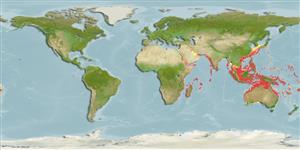Environment: milieu / climate zone / depth range / distribution range
Ecologie
marien demersaal; diepte 18 - 141 m (Ref. 4900). Tropical
Indo-West Pacific: Persian Gulf and Red Sea, through the northern Indian Ocean to the South China Sea, north to southern Japan and south to the Indo-Australian Archipelago and New Caledonia. Report from Madagascar needs confirmation.
Grootte / Gewicht / Leeftijd
Maturity: Lm ? range ? - ? cm
Max length : 13.0 cm TL mannelijk / geslacht onbekend; (Ref. 9824)
Dorsale zachte stralen (totaal): 83-98; Anale zachte stralen: 65 - 77; Wervels: 41 - 42. Body with a large dark spot posteriorly on the base of both the dorsal and anal fins and with elongated anterior rays in the dorsal fin.
Inhabits sand, mud, and gravel bottoms (Ref. 9824). Feeds on benthic animals (Ref. 8924).
Levenscyclus en paargedrag
Maturiteit | Voortplanting | Paaien | Eieren | Fecunditeit | Larven
Amaoka, K., O. Okamura and T. Yoshino, 1992. First records of two bothid flounders, Grammatobothus polyophthalmus and Arnoglossus tapeinosoma, from Japan. Jap. J. Ichthyol. 39(3):259-264. (Ref. 9203)
Status op de Rode Lijst van het IUCN (Ref. 130435)
Gevaar voor de mens
Harmless
Gebruik door de mens
Visserij: van minder commercieel belang
Meer informatie
Lokale namenSynoniemenMetabolismePredatorenEcotoxicologieVoortplantingMaturiteitPaaienPaaiaggregatiesFecunditeitEierenOntwikkeling van de eieren
ReferentiesAquacultuurAquacultuurprofielKweeklijnenGeneticaElectrophoresesErfelijkheidZiektesVerwerkingNutrientsMassaconversie
Tools
Speciale rapporten
Download XML
Internetbronnen
Estimates based on models
Preferred temperature (Ref.
123201): 23.3 - 28.3, mean 27.1 °C (based on 792 cells).
Fylogenetische diversiteitsindex (Ref.
82804): PD
50 = 0.5000 [Uniqueness, from 0.5 = low to 2.0 = high].
Bayesian length-weight: a=0.00912 (0.00408 - 0.02036), b=3.05 (2.87 - 3.23), in cm total length, based on LWR estimates for this (Sub)family-body shape (Ref.
93245).
Trofisch niveau (Ref.
69278): 3.5 ±0.37 se; based on food items.
Weerstandsvermogen (Ref.
120179): Gemiddeld, minimale populatieverdubbelingstijd 1,4-4,4 jaar (Preliminary K or Fecundity.).
Fishing Vulnerability (Ref.
59153): Low vulnerability (10 of 100).
